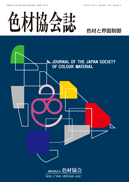All issues

Predecessor
Volume 89, Issue 6
Displaying 1-6 of 6 articles from this issue
- |<
- <
- 1
- >
- >|
Special Edition Color Lessons from Mother Nature
-
Ryuichiro KURATA2016 Volume 89 Issue 6 Pages 177
Published: June 20, 2016
Released on J-STAGE: September 20, 2016
JOURNAL FREE ACCESSDownload PDF (256K)
Review
-
Mechanisms and Ethological SignificanceNoriko OSHIMA2016 Volume 89 Issue 6 Pages 178-183
Published: June 20, 2016
Released on J-STAGE: September 20, 2016
JOURNAL FREE ACCESSFish skin color is generated by the specialized integumentary cells, “chromatophores”, which are classified into two types, the light-absorbing chromatophores and the light-reflecting chromatophores. In the former cells, light rays of certain wavelengths are absorbed by pigmentary substances present within the cells. In the latter cells, the reflection of light is caused by intracellular structures with refractive indices different from cytoplasmic matrix, and structural color is produced. Many chromatophores possess specific receptors for various neurotransmitters and hormones in the cellular membrane, and these substances cause the motile activities of chromatophores through their specific receptors. The changes in hue or in color patterns are due to the chromatophore movements. For fish lacking the ability of vocal communications, chromatic states should be of extraordinary importance in discrimination of individuals of the same species from others, and the color changes are used for communication between or among individuals. Further, some fish intimidate predators by loud colors, and there are many fish which adapt themselves to background color or color patterns to avoid being noticed by predators and/or prey (“camouflage”). Thus, the chromatic phenomena are very important for survival of fish and for maintenance of species.View full abstractDownload PDF (1895K) -
-Function and Background-Gen MORIMOTO2016 Volume 89 Issue 6 Pages 184-190
Published: June 20, 2016
Released on J-STAGE: September 20, 2016
JOURNAL FREE ACCESSDiversity in bird coloration is very high. Bird color is mainly plumage coloration. Plumage coloration is mainly produced from two types of pigment and from feather microstructure and is classified into three types: carotenoid-based, melanin-based, and structural-based coloration. This paper describes an overview of bird coloration: coloring, biological/ecological function, evolution mechanism as background, color vision and biomimetics.View full abstractDownload PDF (1926K) -
Mantaro HIRONAKA, Takahiko HARIYAMA2016 Volume 89 Issue 6 Pages 191-196
Published: June 20, 2016
Released on J-STAGE: September 20, 2016
JOURNAL FREE ACCESSMost animals show the species-specific color preference that an individual responds to a certain range of the spectrum of visible light. Color preference of insects is a quite conspicuous phenomenon, attracting attention in basic and applied sciences. In this paper, we try to give an overview of a color preference and the biological significance in insects, and the practical applications regarding the current status and future possibilities for the insect pest control.View full abstractDownload PDF (1782K)
Serial Lecture
-
-Method to Measure and to Convey a Color Appropriately-Chihiro NAGANO2016 Volume 89 Issue 6 Pages 197-202
Published: June 20, 2016
Released on J-STAGE: September 20, 2016
JOURNAL FREE ACCESS“Color” gives design or function or both effects to objects, therefore it provides added value. Color-digitizing methods are applied at manufacturing sites in order to confirm color reproducibility and it is necessary to measure color on objects with suitable measuring apparatus. Unfortunately the measurements depend on optical conditions and sometimes the state of the sample, i.e. measuring temperature, surface scratch, surface stain, and so on. Thus when these conditions fluctuate it is impossible to understand the real state of products. In the present paper the important points to note when measuring color will be advocated, including the selection of the light conditions of the measuring machine to match the sample.
In addition an outline of color-difference formula will be given in order to quantitatively compare the measurements.View full abstractDownload PDF (876K)
-
Yoshimune NONOMURA2016 Volume 89 Issue 6 Pages 203-206
Published: June 20, 2016
Released on J-STAGE: September 20, 2016
JOURNAL FREE ACCESSEmulsions stabilized by solid particles at liquid-liquid interfaces are called Pickering emulsions. Solid particles stabilize not only O/W and W/O emulsions but also O/O, W/W, multiple, and non-spherical emulsions, foams, liquid droplets and bi-continuous liquid crystal phases. These structures have been applied in stimuli responsive materials, micro-reactors, catalysts, analytical systems, medical, cosmetic and food products. Some recent findings are described in the present paper.
View full abstractDownload PDF (637K)
- |<
- <
- 1
- >
- >|